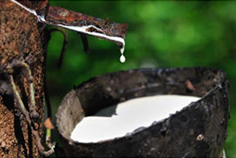Latex and food allergens
 Natural rubber latex is a substance extracted from the sap of the gum tree. It is used to manufacture rubber gloves, condoms, balloons, dummies, tyres and catheters.
Natural rubber latex is a substance extracted from the sap of the gum tree. It is used to manufacture rubber gloves, condoms, balloons, dummies, tyres and catheters.
Products made of latex are ever-present in medical settings and the home environment, meaning avoiding contact with latex is not easy.
It is estimated that around 13 million people worldwide live with latex allergy.
In the 1980s, there was a rapid increase in production of latex gloves to prevent transmittable infections in medical environments. This resulted in an outbreak of latex allergy among healthcare workers and individuals with food allergies (bananas, kiwi, avocado, and chestnuts), and specific health problems such as spina bifida.
Studies have shown that latex may contain hundreds of allergenic proteins, but only fifteen of them have been given names so far. These proteins are similar to those present in some plant-derived foods.
Most common foods cross-reacting with latex
The most commonly reported cross-reactive foods include banana, avocado, kiwi, and chestnut together with papaya, fig, potato, and tomato. The relationship between latex allergy and allergy to plant foods is called latex fruit syndrome.
Cross-reactions may occur between the residual parts of plant proteins in the latex rubber and proteins in foods, just like cross-reactions between pollen and foods. Around 30-50% of people with latex allergy experience an allergic reaction when eating one or more of these foods.
Management of latex allergy
If you have a latex allergy you should:
- Avoid the products containing latex and also the foods that trigger symptoms.
- Inform medical professionals and family and friends of latex allergy.
- Wear a medical alert bracelet containing the words latex allergy.
- Always carry an adrenaline auto-injector, in case you experience anaphylaxis.
In the medical setting, a latex free environment may not be achievable, but through education of personnel and having protocols (instructions on how to behave if someone has a reaction to latex), a latex safe environment can be established.
Further reading
- Chapman JA et al. (2014) Food allergy: a practice parameter
- Werfel, T., Asero, R., Ballmer‐Weber, B. K., et al. (2015) Position paper of the EAACI: food allergy due to immunological cross‐reactions with common inhalant allergens
